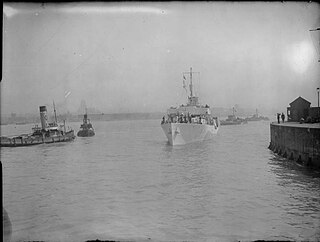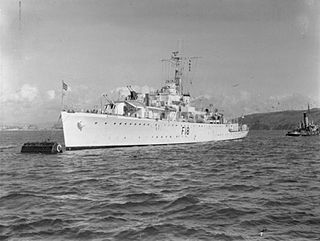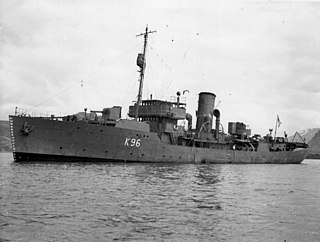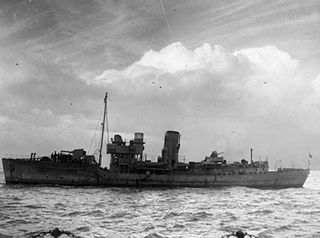
HMS Arbutus was a Flower-class corvette of the Royal Navy, which was active during the Second World War. She was a successful escort vessel, and took part in the destruction of two U-boats during the Battle of the Atlantic. Arbutus was torpedoed by a U-boat and sunk in the North Atlantic in February 1942 while aiding a convoy that was under attack.

USS Surprise (PG-63), the fourth American naval ship of the name, was a Temptress-class patrol gunboat during World War II. She was built as the British Flower-class corvette HMS Heliotrope, and was in service with the Royal Navy during the first years of the Battle of the Atlantic. She was loaned to and operated by the United States Navy from 1942 to 1945. After World War II, she was sold as a merchant vessel and ended her life in the Chinese navy as Lin I.

HMS Begonia was a Flower-class corvette that served in the Royal Navy during World War II. In 1942 she was lent to the United States Navy and commissioned as USS Impulse. Returned to the Royal Navy in 1945, Begonia was stricken and sold into merchant service. She was wrecked off the coast of Spain in 1970.

HMS Bellwort was a Flower-class corvette built for the Royal Navy during World War II.
HMS Arabis was a Flower-class corvette of the Royal Navy. The ship was commissioned into the Royal Navy as HMS Arabis. She was transferred to the United States Navy in 1942, serving as USS Saucy. Returned to the United Kingdom in 1945, she was recommissioned into the Royal Navy as HMS Snapdragon.
When the United States entered World War II at the end of 1941, the United States Navy found itself deficient in ocean escort-type vessels. A crash building program was instituted; but, to meet more immediate needs, the government contracted with shipbuilding firms in England and Canada to build Flower-class corvettes. Vim (PG-99) was one of those British-type escorts. She was launched on 1 April 1943 at the Collingwood Shipyard in Collingwood, Ontario. Nine days later, however, she was transferred to the Royal Navy under the terms of the lend-lease agreement in return for another Flower-class corvette then under construction in Canada. The British renamed her HMS Statice, and she served the Royal Navy under the name through World War II. On 21 June 1946, she was returned to the United States Navy. Though carried on the Navy list as PG-99, the corvette never saw active service with the United States Navy. She was sold on 7 May 1947. To whom she was sold and to what purpose she was put is unknown.

HMCS Rosthern was a Flower-class corvette that served in the Royal Canadian Navy during the Second World War. She served primarily in the Battle of the Atlantic as a convoy escort. She is named for Rosthern, Saskatchewan.

HMS Witherington was an Admiralty modified W-class destroyer built for the Royal Navy. She was one of four destroyers ordered in April 1918 from James Samuel White & Co Ltd. under the 14th Order for Destroyers of the Emergency War Program of 1917–18. She was the first Royal Navy ship to carry this name.
HMS Veronica was a Flower-class corvette, built for the Royal Navy during the Second World War, and was in service in the Battle of the Atlantic. In 1942 she was transferred to the United States Navy as part of the reverse Lend Lease arrangement and renamed USS Temptress, the name ship of the Temptress-class gunboats. With the end of hostilities she was returned to the Royal Navy and sold into mercantile service.
HMS Calendula was a Flower-class corvette, built for the Royal Navy during the Second World War, and was in service in the Battle of the Atlantic. In 1942 she was transferred to the United States Navy as part of the reverse Lend Lease arrangement and renamed USS Ready, one of the Temptress-class gunboats. With the end of hostilities she was returned to the Royal Navy and sold into mercantile service.
HMS Candytuft was a Flower-class corvette, built for the Royal Navy during the Second World War, and was in service in the Battle of the Atlantic. In 1942 she was transferred to the United States Navy as part of the reverse Lend Lease arrangement and renamed USS Tenacity, one of the Temptress-class gunboats. With the end of hostilities she was returned to the Royal Navy and sold into mercantile service.
HMS Oxlip was a Flower-class corvette that served in the Royal Navy during World War II.

HMS Flamingo was a Black Swan-class sloop of the Royal Navy. She saw service as a convoy escort during the Second World War, seeing extensive service in the Mediterranean and Far East in 1945.

HMS Enchantress (L56) was a Bittern-class sloop, built for the British Royal Navy. She was the lead ship of her class, being laid down as Bittern, but renamed as Enchantress before being launched by Lady Jean Alice Elaine Cochrane. She was active during the Second World War, serving mainly as a convoy escort, and was a successful anti-submarine warfare vessel, being credited with the destruction of an Italian submarine in 1942.

HMS Rhododendron was a Flower-class corvette that served with the Royal Navy during the Second World War. She served as an ocean escort in the Battle of the Atlantic.

HMS Aubrietia (K96) was a Flower-class corvette built for the Royal Navy (RN) from 1941-1946. She was active as a convoy escort in the Atlantic and Mediterranean. In May 1941, Aubrietia sighted and depth charged the German submarine U-110, leading to its capture and the seizure of a German Naval Enigma and its Kurzsignale code book.

HMS Hibiscus was a Flower-class corvette, built for the Royal Navy during the Second World War, and was in service in the Battle of the Atlantic. In 1942 she was transferred to the United States Navy as part of the Reverse Lend-Lease arrangement and renamed USS Spry, one of the Temptress-class gunboats. With the end of hostilities she was returned to the Royal Navy and sold into mercantile service.

HMS Periwinkle was a Flower-class corvette, built for the Royal Navy during the Second World War, and was in service in the Battle of the Atlantic. In 1942 she was transferred to the United States Navy as part of the Reverse Lend-Lease arrangement and renamed USS Restless, one of the Temptress-class gunboats. With the end of hostilities she was returned to the Royal Navy and sold into mercantile service.

HMS Larkspur was a Flower-class corvette, built for the Royal Navy during the Second World War, and was in service in the Battle of the Atlantic. In 1942 she was transferred to the United States Navy as part of the Reverse Lend-Lease arrangement and renamed USS Fury, one of the Temptress-class gunboats. With the end of hostilities she was returned to the Royal Navy and sold into mercantile service.

HMS Chanticleer was a modified Black Swan-class sloop of the Royal Navy. She was laid down by William Denny and Brothers, Dumbarton on 6 June 1941, launched on 24 September 1942 and commissioned on 29 March 1943, with the pennant number U05.














